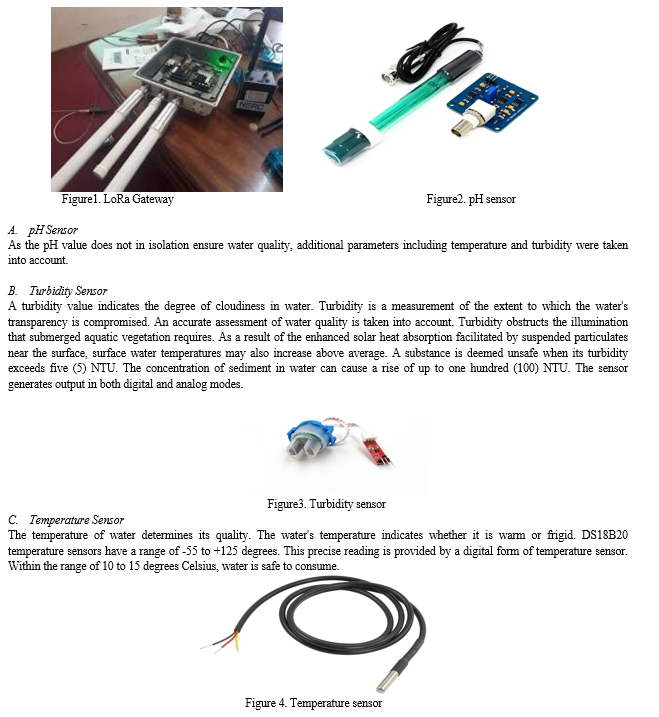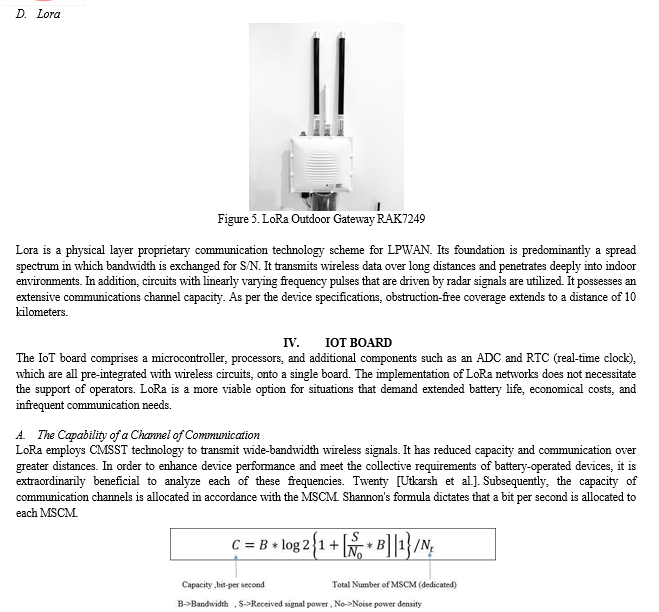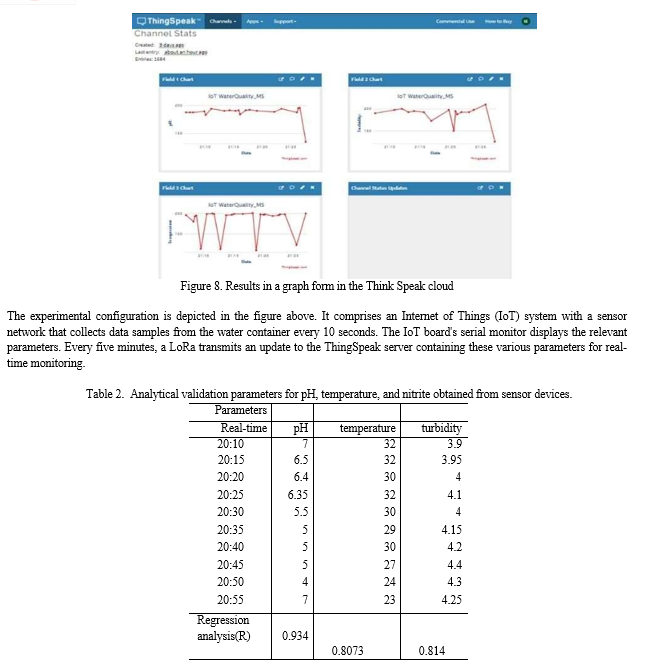Ijraset Journal For Research in Applied Science and Engineering Technology
- Home / Ijraset
- On This Page
- Abstract
- Introduction
- Conclusion
- References
- Copyright
IoT-based Design and Implementation of an Intelligent Water Quality Monitoring System
Authors: Dr. A. Gowthaman, Dr. M. Mohammadha Hussaini, Dr. P. Govindasamy
DOI Link: https://doi.org/10.22214/ijraset.2024.61111
Certificate: View Certificate
Abstract
Water is an essential requirement for human survival, and a scarcity of water renders us unable to sustain our lives. The issue of water pollution and shortage is a pressing worldwide concern that necessitates the adaptation of water resources and the establishment of guiding principles at both the international and individual levels. Water contamination is the primary contributor to global disease outbreaks. In the past, the process of monitoring water quality relied on the physical collection of data, lacking the implementation of a smart sensor system. This resulted in inefficiencies, particularly in the areas of real-time data retrieval, device surveillance, and less precise data gathering. The integration of a real-time water quality monitoring method is important in order to guarantee the provision of a secure drinking water supply. Therefore, the concept of the Internet of Things (IoT), which facilitates the interconnection of diverse devices for the purpose of data interchange and collection, has emerged. A proposed solution to address these problems is the development of a cost-effective real-time platform that utilizes the Internet of Things (IoT) and LoRa (LongRange) technology for the purpose of monitoring water quality. The sensor data collected by the Lora Getaway will be transmitted to the cloud server via the internet. A Matlab analysis and visualization program is integrated into the cloud server to alter and analyze data for the purpose of monitoring water quality. Ultimately, the pertinent data is represented in a visual format within the user domain to facilitate the decision-making process. This study posits that the suggested platform holds significant importance in guaranteeing a secure provision of high-quality potable water for individuals around the globe.
Introduction
I. INTRODUCTION
There is no living thing that exists without water. We cannot survive in the absence of water. There is approximately 71% of the Earth's surface that is covered by water, with 96.5% of the water being found in the ocean and only 3% being fresh water. Due to the fact that just three percent of water is fresh, one of the new issues that the actual world faces is the provision of clean and safe drinking water. As It is estimated that by the year 2017, there will be at least 2.3 billion people around the world who do not have access to drinking water that is guaranteed (WHO,). It is a major decline in the availability of high-quality drinking water has occurred as a consequence of the limited resources of drinking water and the steadily increasing population. The rapid increase in population has led to an increase in the amount of pollutants in the water supply. The monitoring of water quality in real time is fraught with difficulties in this scenario due to the fact that global warming and restricted water resources are both factors. As a result, it is essential to look for a solution for monitoring the quality of the water and a control system. In light of this, there is a pressing requirement for the development of improved techniques that can monitor the parameters of water quality in real time. The concentration of hydrogen ions is measured by the characteristics that determine the quality of the water, such as pH. This reveals whether the water is acidic or alkaline in nature. The pH spans from 0 to 14 on the scale. Because the pH value of pure water is seven, it can be deduced that the water is acidic if it has a pH value that is lower than seven. When the pH of the water is greater than 7, on the other hand, it is said to be alkaline. The pH level should be between 6.5 and 8.5 for water to be drinkable. Turbidity, on the other hand, is a measurement of the vast number of invisible particles that are suspended in water. When the turbidity of the water is higher, the likelihood of the people who drink it contracting diarrhea or cholera is also higher. Contrarily, the water is considered to be cleaner when the turbidity level is lower. Additionally, a temperature sensor can determine if water is cold or hot or vice versa. The manual collecting of water samples from a variety of sites was the conventional way of monitoring the quality of the water supply. As a result, the Internet of Things (IoT) is a revolutionary new concept that has the potential to make nearly anything "smart." In this particular context, the term "Thing" refers to an object that includes a heart monitor, a temperature sensor, and other similar devices.
Countless individuals have become captivated by this remarkable technological advancement. Why is this such a big deal right now? Consequently, picture a world in which machines operate without any concept of human interaction anywhere in the planet. Imagine a future in which machines are able to speak with one another and make decisions based on the data they have acquired, without the need for an end-user to be involved. The Internet of Things (IoT) is a technology that makes use of collection devices that collaborate with one another (also known as the network of devices) to connect with one another with the assistance of a controller. The capability to transmit information about the environment around it is possessed by it. Microchips, sensors, and embedded systems are the components that make up these devices for data analysis.
The purpose of this study is to investigate the possibility of monitoring water quality by means of the collection of vital information and the establishment of connection with the end-user through the utilization of LoRa Gateway and technology. The platform will concurrently enable data access, reliable data collecting, and supervision of the component. This will allow the user to be aware of any instances in which the virtual device is not getting any data at a particular time interval. Sensor devices, an Internet of Things Board, a LoRa Gateway, a cloud server, and a user domain will make up the ten distinct components that will make up the platform. For the purpose of transmitting the sensor data to the cloud server over the internet, the Lora wireless data transfer will be utilized. Matlab is a program for data manipulation and visualization that is installed on the cloud server. This application allows for the monitoring of the water's quality through the manipulation and analysis of data. The user interface that is based on the web allows users to interact with content that is kept on cloud servers through the use of web browsers.
The purpose of this study is to install several sensors that measure the quality of the water. Many parameters are necessary for conducting an analysis of the water's quality. The list of sensors that are most commonly utilized for the purpose of determining the quality of water is presented in Table 1 below. Throughout the course of our investigation, we have utilized sensors for temperature, pH, and turbidity in order to measure the aforementioned factors.
Table 1: Description of water quality sensors
|
Name of sensors |
Description of the sensors |
|
Temperature sensor |
Measure temperature of its environment. |
|
pH sensor |
Determines the acidic or basic of the water. |
|
Turbidity sensor |
Determines the number of solid particles. |
|
Conductivity sensor |
It is Indicates the number of dissolved ions existing in the water. |
|
Dissolved oxygen sensor |
This varies as per temperature, Measure theamount of dissolved oxygen in the water. |
|
Conductivity sensor |
Determines ionic strength in water. |
|
Humidity |
Measure humidity of its surrounding |
II. OBJECTIVES OF THE RESEARCH
The Internet of Things will be utilized in order to design and create a smart water quality monitoring system as the primary purpose of this project. Among the specific goals that will be accomplished are the following:
- Design the system that will be capable of sensing the water quality in real time on a variety of water parameters, including pH, turbidity, and temperature, for internal usage.
- Create the computer code that will be used to operate the sensors on the device.
- Utilize the Internet of Things to perform data analysis in the cloud.
III. APPROACH
By collecting data on water characteristics such as pH, turbidity, and temperature, the proposed system is able to reduce the complexity of the system while simultaneously increasing its performance. The information that is gathered is stored in the cloud, where it is constantly up dated and can be downloaded from any location in the globe. The acidity or alkalinity of a solution can be represented by its pH, which is a measurement of the solution's pH. The logarithmic scale that represents the pH scale has a range that extends from 0 to 14, with seven (7) serving as the neutral point. A basic or alkaline solution is indicated by values that are greater than seven (7), whilst an acidic solution is indicated by values that are less than seven (7).
A 5V power supply is required for the system to function, and it is simple to link with an Internet of Things board. The pH has a typical range that goes from 6 to 8.5. In order to determine the pH of an aqueous solution, it is necessary to have knowledge of the concentration of the hydronium ion, which is expressed in moles per liter (liters). A calculation of pH is performed by applying the following equation: pH = - log [H3O+].


At present, the capacity of each communication channel for an MSCM base station equipped with n sensors is determined by factors such as interference, data rate, transmitted power efficiency, and receiver sensitivity.
B. Think Speak Server
ThingSpeak is an application for collecting data from the Internet of Things that analyzes sensors such as pH, turbidity, and temperature. Data is gathered by the data collector from periphery node devices. Jain and Das [21]. Instant visualisations of real-time data from the internet are accessed by end-users via mobile applications and web browsers. To expedite the development of IoT analytics, new sensor data are analyzed and visualized using Matlab code. Following the collection of data from various sensor nodes, end-users access the data via TCP as the transport layer and one of the TTN protocols called Message Queuing Telemetry Transport (MQTT), according to our research. The applicable security protocol is Transport Layer Security (TLS).
C. Web-Based User Interface
By utilizing web browsers, the web-based user interface permits users to interact with content hosted on cloud servers.
V. PROPOSED SYSTEM
The IoT-based water quality monitoring system that has been implemented in this study is depicted in Figure 5. The established system has been specifically engineered to ascertain parameters of the encompassing atmosphere, including pH, turbidity, and temperature.
A water container, an IoT board, and a LoRa Gateway serving as the communication module are its components. The proposed method's overall block diagram illustrates the manner in which sensors gather up-to-the-minute data on water quality parameters, including temperature, pH, and turbidity, with in the presented IoT environment. The IoT board is linked to the block diagram under consideration, which comprises a number of sensors (temperature, pH, turbidity). The IoT device processes the sensor values by establishing a communication channel with the end-user via the internet and LoRa Gateway. The IoT module functions as the fundamental controller. A complex intelligent application is installed on the cloud server to manipulate and analyze the data.


Conclusion
This study implements a cost-effective and efficient Internet of Things (IoT) solution for a smart water quality monitoring system through the utilization of a LoRa Gateway. The system can automatically monitor water quality, The pH value obtained varies between 6.5 and 8.5. The voltage range of a turbidity sensor is as follows: 3.90V to 4.55V for clear water, 2.70V to 3.89V for cloudy water, and 0.01V to 2.69V for ducking water. The sensor measures the amount of light that can sufficiently travel through the water. By utilizing webservers and a web-based application known as ThingsSpeak, the pH value, ambient temperature, and turbidity of the water were monitored. It was determined that water quality testing was more economical, practical, and rapid. The system possesses commendable adaptability. By substituting the appropriate sensors and modifying the corresponding software applications, this system is capable of monitoring an additional range of water quality parameters. The process is straightforward. Cost is minimal and time is limited in this environmental management endeavor. With a limited data rate, LoRa technology is extensively utilized for long-distance communication, the report concludes. A regression analysis in which R is greater than 0.8 indicates the presence of a robust correlation among the variables and a connection between two continuous variables. Moving forward, it will be necessary to enhance network performance in order to achieve better coverage. This can be achieved by integrating a greater number of gateways and sensors into a larger network and utilizing Big Data and Artificial Intelligence algorithms to address various water contamination issues in coastal regions. The objective is successfully determined utilizing the proposed model.
References
[1] Mohamed Alshehri, Akashdeep Bhardwaj, Manoj Kumar, Shailendra Mishra, Jayadev Gyani,(2021), Cloud and IoT based smart architecture for desalination water treatment, Environmental research, volume 195.m110812. https://doi.org/10.1016/j.envres.2021.110812. [2] Purkayastha, K.D., Mishra, R.K., Shil, A. et al. (2021). IoT Based Design of Air Quality Monitoring System Web Server for Android Platform. Wireless Pers Commun. https://doi.org/10.1007/s11277-021-08162-3. [3] U. Alset, A. Kulkarni and H. Mehta, (2020). \"Performance Analysis of Various LoRaWAN Frequencies For Optimal Data Transmission Of Water Quality Parameter Measurement,\" 11th International Conference on Computing, Communication and Networking Technologies (ICCCNT), 2020, pp. 1-6, doi: 10.1109/ICCCNT49239.2020.9225615. [4] Sithole M.P.P., Nwulu N.I., Dogo E.M. Malatya; Turkey: (2019). Development of a Wireless Sensor Network Based Water Quality Monitoring and Notification System, International Conference on Artificial Intelligence and Data Processing (IDAP) pp. 1–9. [5] Shafi, Uferah, Mumtaz, Rafia, Anwar, Hirra, Mustafa Qamar, Ali, Khurshid, Hamza, (2018). Surface Water Pollution Detection Using the Internet of Things. School of Electrical Engineering and Computer Science, National University of Science and Technology, IEEE Conference, pp. 92–96. [6] Siregar, Baihaqi, Menen, Krisna, Efendi, Syahril, Andayani, Ulfi, (2017). Monitoring quality standard of waste water using wireless sensor network technology for smart environment. In: The International Conference on ICT for Smart Society (ICISS).
Copyright
Copyright © 2024 Dr. A. Gowthaman, Dr. M. Mohammadha Hussaini, Dr. P. Govindasamy. This is an open access article distributed under the Creative Commons Attribution License, which permits unrestricted use, distribution, and reproduction in any medium, provided the original work is properly cited.

Download Paper
Paper Id : IJRASET61111
Publish Date : 2024-04-27
ISSN : 2321-9653
Publisher Name : IJRASET
DOI Link : Click Here
 Submit Paper Online
Submit Paper Online

